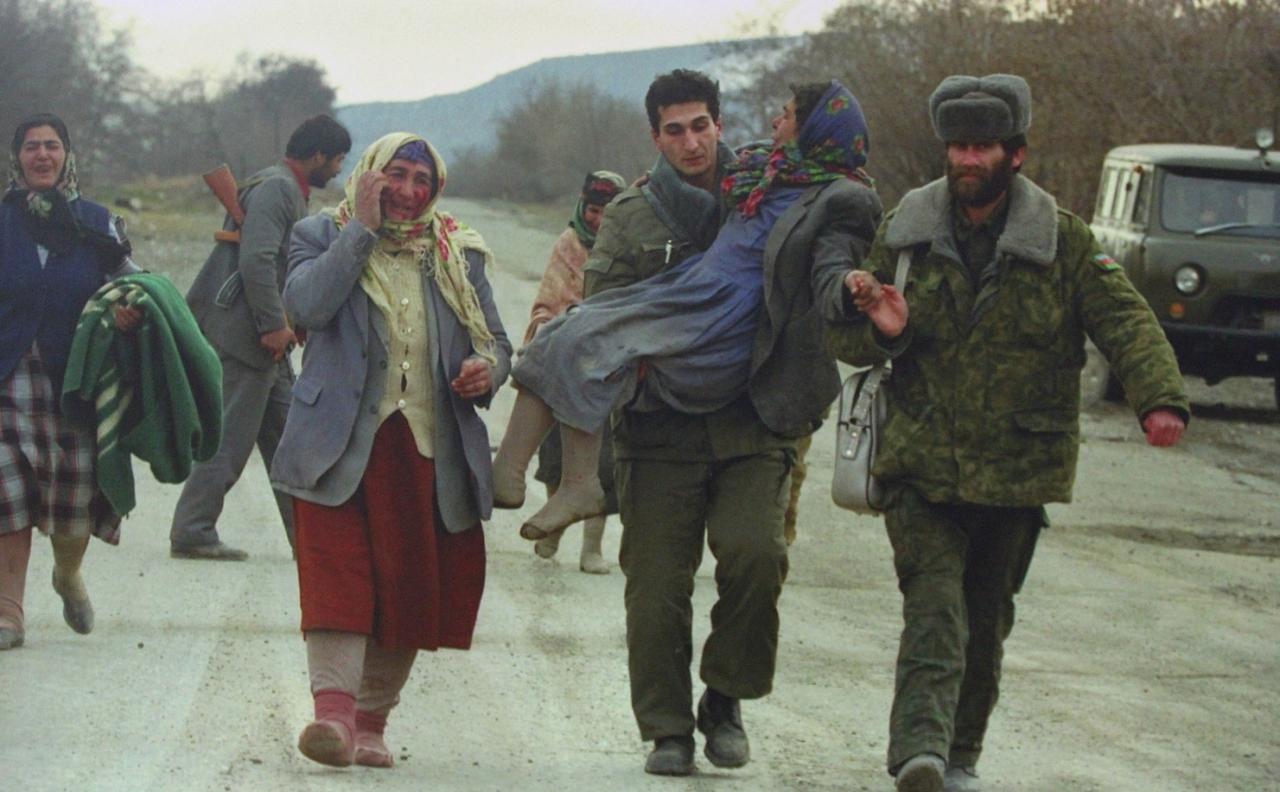Khojaly Massacre: Bloody page in Azerbaijan's history

By Amina Nazarli
“I remember that cold night from February 25 to 26, when we walked through the woods, sinking into deep snow. So many people died there. But you should have seen those who survived ... how many of them had a heart attack, many were injured, while others remained in captivity, and no one knows anything about their fate,” says Hasrat Khalilova, a survivor of the Khojaly massacre.
February 26 marks the 25th anniversary of the Khojaly Genocide,
one of the most horrible tragedies, which Azerbaijani people faced
in the 20th century, during the Nagorno-Karabakh, started when
Armenia made territorial claims against Azerbaijan. The night
claiming the life of 613 civilians mostly women and children, and
leaving 1,000 people stayed disabled and 1,275 held hostage.
The refugee from Khojaly, who lost many members of her family,
reminded the life in the city before the tragedy. “We lived happy,
we had flowering gardens, planted with our own hands. We had no
need in Khojaly. It was a big city,” said Khalilova.
Within one night, Khojaly, one of the oldest settlements in Karabakh with a population of about 7,000 people, was razed to the ground.
It began when Russian 366th Regiment and Armenian fighters
surrounded the town of Khojali from four directions, opening heavy
and ceaseless fire from artillery and salvo launchers. Within a
short time, the city was enveloped in flames of fire. The defending
army and local population had to leave town.
Hoping to escape the aggressive and insidious Armenian soldiers,
the population of the town run to the mountains and forests in
frosty February night. Armenian armed forces pursued them there and
were jeering at them cruelly. Many young girls were taken hostages,
many civilians were shot at close range, scalped or burned alive
and many of those froze to death.
Many foreign publications were shocked of what they saw that day. The Russian newspaper Moskovsky Komsomolets wrote on January 29, 1994: "We have seen prisoners from Khojaly. Almost all of them were unfit for normal life. In cold weather they were kicked half-naked out into the street, doused with icy water, glass was smashed over their heads... An Armenian cut a baby’s body into two and began to beat his mother with one half. The mother, soaked in blood, suddenly started laughing ... She went mad...”
Over 200 years Azerbaijan has endured ethnic cleansing and genocide by Armenian chauvinists. Azerbaijanis were expelled from their historical lands, became refugees and IDPs, and all this was accompanied by massacres committed by Armenians.
The events that unfolded over Nagorno-Karabakh in 1988, the
desire of Armenian ideologists to implement crazy idea called
"Armenia from sea to sea" led to the destruction of villages,
cities and the deaths of tens of thousands of innocent people, the
expulsion of hundreds of thousands of Azerbaijanis from their
historical lands.
Historian Lala Aliyeva said Armenians wanted to clear
Nagorno-Karabakh from Azerbaijanis and the genocide was arranged to
scare Azerbaijanis to make them leave their villages.
“Khankendi city in Azerbaijan’s Nagorno-Karabakh region is controlled by Armenians since 1989. Whereupon, Shusha and Khojaly remained two large settlements consisted of Azerbaijanis in the Nagorno-Karabakh. Armenians were unable to arrange the massacre in Shusha, since Shusha was located on a steep hill and has a large population. But Khojaly was more "affordable,” she explained.
Despite the country formed volunteer troops to fight against Armenians in Nagorno- Karabakh, Azerbaijan was not recovered yet at the time after securing independence in 1991. That’s why the population of border villages were in a panic after the horrors committed by Armenian forces.
“After the Khojaly tragedy, residents of Azerbaijani villages
had to leave their houses before the Armenian began attacking,”
Aliyeva said.
Thus, Khojali was chosen by Armenian extremists deliberately. The
fact that the city was populated only by ethnic Azerbaijanis is
enough to argue that it was a genocide, as the Armenian soldiers
killed civilians on ethnic grounds.
Today, thousands of Baku residents arrive at the Khojaly
memorial every February 26 to pay tribute to the victims of the
genocide. Numerous events are organized in different cities and
regions across Azerbaijan to commemorate the tragedy.
In an interview with British journalist Thomas de Waal on December
15, 2000, Serzh Sargsyan, then the commander of breakaway Nagorno
Karabakh's military forces and current president of Armenia,
confessed his involvement in the Khojaly massacre.
“Before Khojaly, the Azerbaijanis thought that they were joking with us; they thought that the Armenians were people who could not raise their hand against the civilian population. We were able to break that [stereotype]. And that’s what happened,” Sargsyan said.
The parliaments of Pakistan, Mexico, Colombia, Romania, Serbia, Bosnia and Herzegovina, Czech Republic, Jordan, as well as the legislative bodies of 20 states of the Unites States, including New-Mexico, Arkansas, Oklahoma, Pennsylvania, Connecticut, Western Virginia, New-Jersey, Tennessee, Arizona and Hawaii have adopted resolutions to recognize the tragic crime as a genocide.
The Organization of Islamic Cooperation (OIC) adopted a final Cairo Communiqué in February 2013, at its summit held in Cairo, labeling the Khojaly tragedy genocide against humanity. The Communiqué calls on the international community to recognize the genocide.
--
Amina Nazarli is AzerNews’ staff journalist, follow her on
Twitter: @amina_nazarli
Follow us on Twitter @AzerNewsAz
Here we are to serve you with news right now. It does not cost much, but worth your attention.
Choose to support open, independent, quality journalism and subscribe on a monthly basis.
By subscribing to our online newspaper, you can have full digital access to all news, analysis, and much more.
You can also follow AzerNEWS on Twitter @AzerNewsAz or Facebook @AzerNewsNewspaper
Thank you!
